Securing the Future: A Resourceful Jamming Detection Method Utilizing the EVM Metric for Next-Generation Communication Systems
Abstract
:1. Introduction
- EVM metric utilization: The paper advocates for the utilization of the EVM metric measured in IQ symbols, a departure from the commonly used classical RSS and BER based metrics in the literature.
- Enhanced sensitivity: The proposed method demonstrates a significant improvement in jamming detection sensitivity compared to existing approaches. Although low-power hidden jamming signals that cannot be detected using conventional metrics do not cause denial of service, they can limit the data transmission rate. Due to the EVM’s ability to detect small variations in jamming level, jamming signals hidden in an extreme form 20 dB below the legal signal are also successfully detected.
- Low complexity: For next-generation networks with low latency requirements, it is advantageous that the proposed method has a low complexity of . This advantage also contributes to the fast response of the system for anti-jamming measures.
- Jammer frequency information: The proposed method calculates the EVM metric for each RB in the received signal. Since RBs represent the frequency domain, the frequency bands in which jamming attacks occur are also revealed. This important information, which is not provided by most methods, offers an important background for countermeasure steps such as jammer localization [40] and antijamming frequency planning. In addition, the concepts of ambient backscattering and RF energy harvesting [41,42] are recently proposed as solutions to the battery problems of IoT devices. By using the jamming frequency information provided by our method, these devices can be tuned to the correct jamming frequencies and, as a result, jamming energy, which is usually emitted at high RF powers, can be utilized.
- Reliability: The EVM vs. RB measurement provides a stable jamming detection performance against varying system parameters such as modulation degree and code rate. However, BER-based methods are affected by the variations of these parameters and provide unreliable results.
- Usability and compatibility: In LTE and 5G systems, it is known that reference IQ symbols are also sent in the transmitted data packet to enable the UE to estimate the channel. The EVM metric used by the proposed method is calculated using these reference symbols that are already in the system architecture. Thus, the proposed method can be easily integrated into the system without the need for changes in system operation or hardware. Moreover, since jamming detection can be performed using a single threshold level for the EVM metric, there is no need for any pre-operational training and validation phases. As a result, the proposed method is suitable for LTE, 5G, and beyond communication systems, which include IQ modulation and resource block (RB) architectures.
- Theoretical analysis support: All presented advantages are substantiated with thorough theoretical analysis, reinforcing the validity and efficacy of the proposed jamming detection methodology.
- Versatility in system scenarios: The proposed method’s successful operation in different system scenarios is underscored by extending the simulation conditions to cover the sub-6 GHz frequency region usage, different numerology (OFDM subcarrier spacing) usage, line-of-sight (LOS) and non-line-of-sight (NLOS) channel cases, MIMO structures, and millimeter-wave (mmWave) band usage scenarios.
- Laboratory experiment validation: The study’s success is conclusively demonstrated through experiments conducted in a laboratory environment, providing empirical evidence of the method’s effectiveness.
2. System Model
- n denotes the index of the IQ symbol,
- N is the total number of symbols used for calculation,
- is the power of the error caused by the jamming and noise,
- and are the reference in-phase and quadrature values of the symbol (),
- and are the estimated in-phase and quadrature values of the symbol (),
- represents the average power of the reference symbols.
3. Simulation Results
3.1. Base Scenario
3.2. Reliability of the Proposed Method against Modulation Type Change
3.3. Reliability of the Proposed Method against Code Rate Change
3.4. Change in the OFDM Subcarrier Space (SCS)
3.5. Jamming Detection for mmWave Conditions
4. In-Lab Validation
5. Discussion
6. Conclusions
Author Contributions
Funding
Data Availability Statement
Conflicts of Interest
Abbreviations
| 3GPP | 3rd Generation Partnership Project |
| 5G | 5th Generation of Cellular Networks |
| BER | Bit Error Rate |
| CDL | Clustered Delay Line |
| DLSCH | Downlink Shared Channel |
| DM-RS | Demodulation Reference Signals |
| DSSS | Direct-Sequence Spread-Spectrum |
| EVM | Error Vector Magnitude |
| FFT | Fast Fourrier Transform |
| IQ | In-phase and Quadrature |
| JNSR | Jamming plus Noise-to-Signal Ratio |
| LOS | Line of Sight |
| LTE | Long-Term Evolution |
| MIMO | Multiple Input, Multiple Output |
| MMSE | Minimum Mean Squared Error |
| NLOS | Non-Line of Sight |
| OFDM | Orthogonal Frequency Division Multiplexing |
| PDSCH | Physical Downlink Shared Channel |
| PSK | Phase Shift Keying |
| QAM | Quadrature Amplitude Modulation |
| QPSK | Quadrature Phase Shift Keying |
| RB | Resource Block |
| RF | Radio Frequency |
| RSS | Received Signal Strength |
| Rx | Receive |
| SCS | Subcarrier Spacing |
| SIMO | Single Input, Multiple Output |
| SJR | Signal-to-Jamming Ratio |
| Tx | Transmit |
| UE | User Equipment |
Appendix A
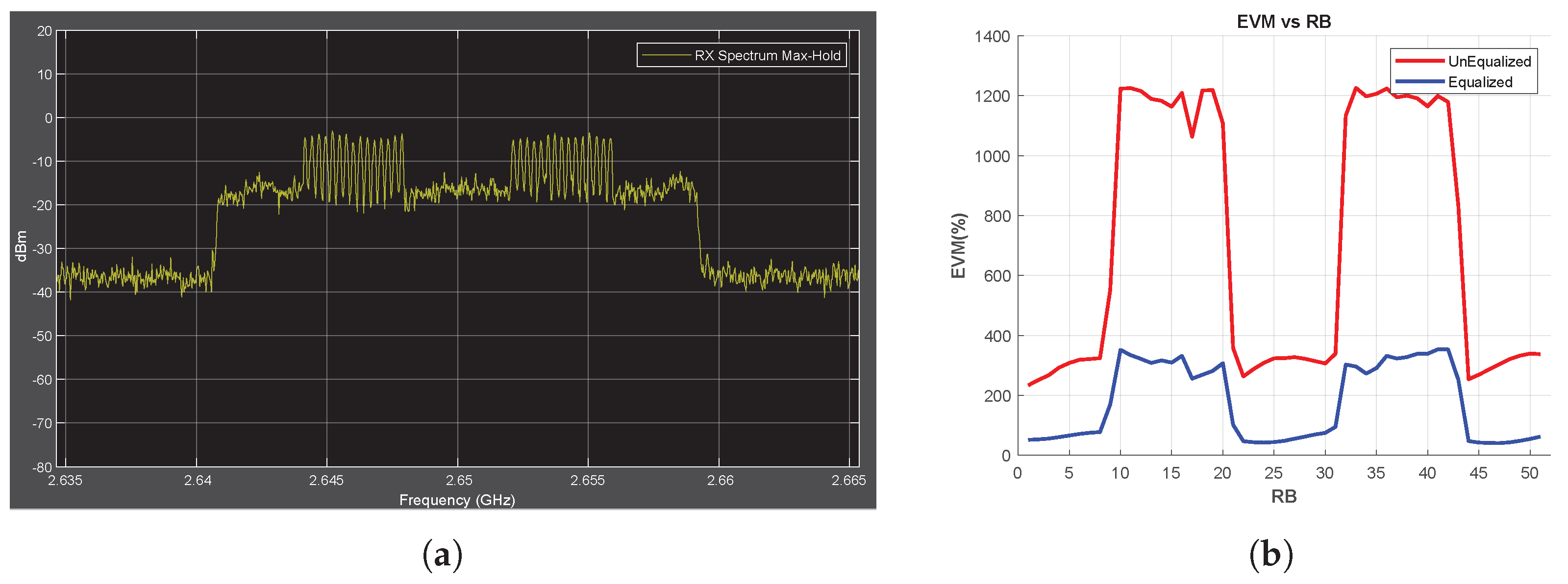
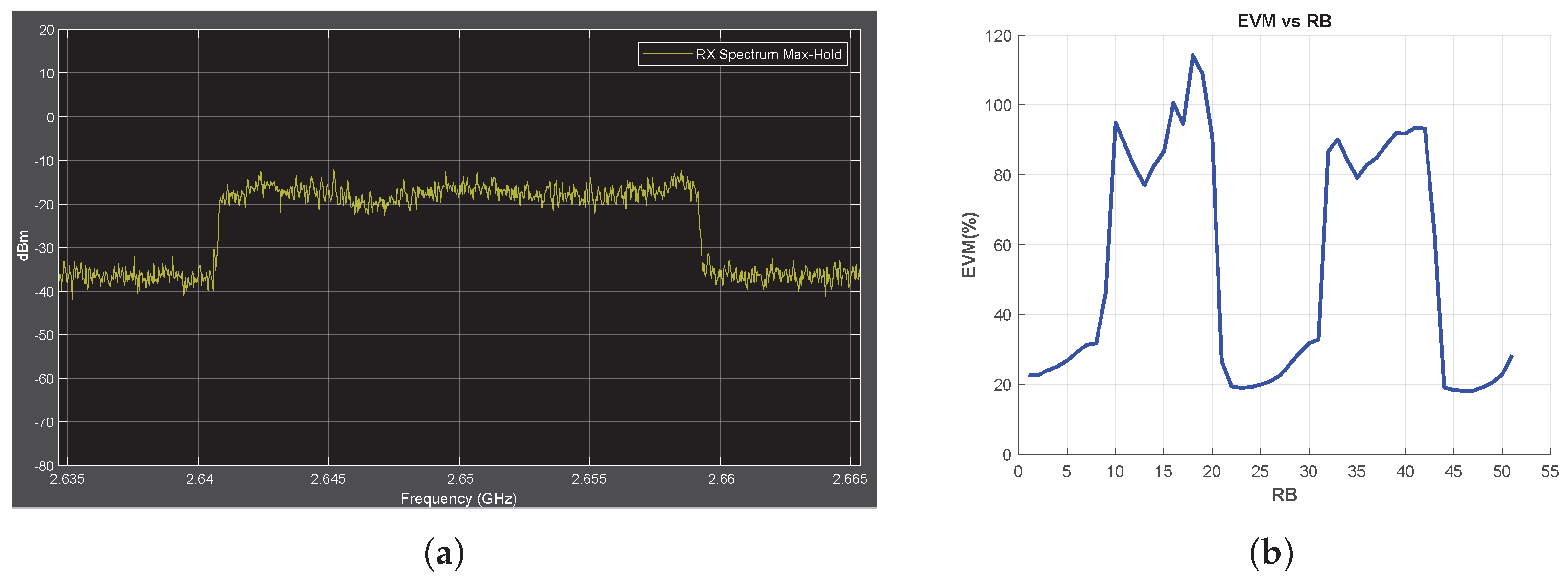

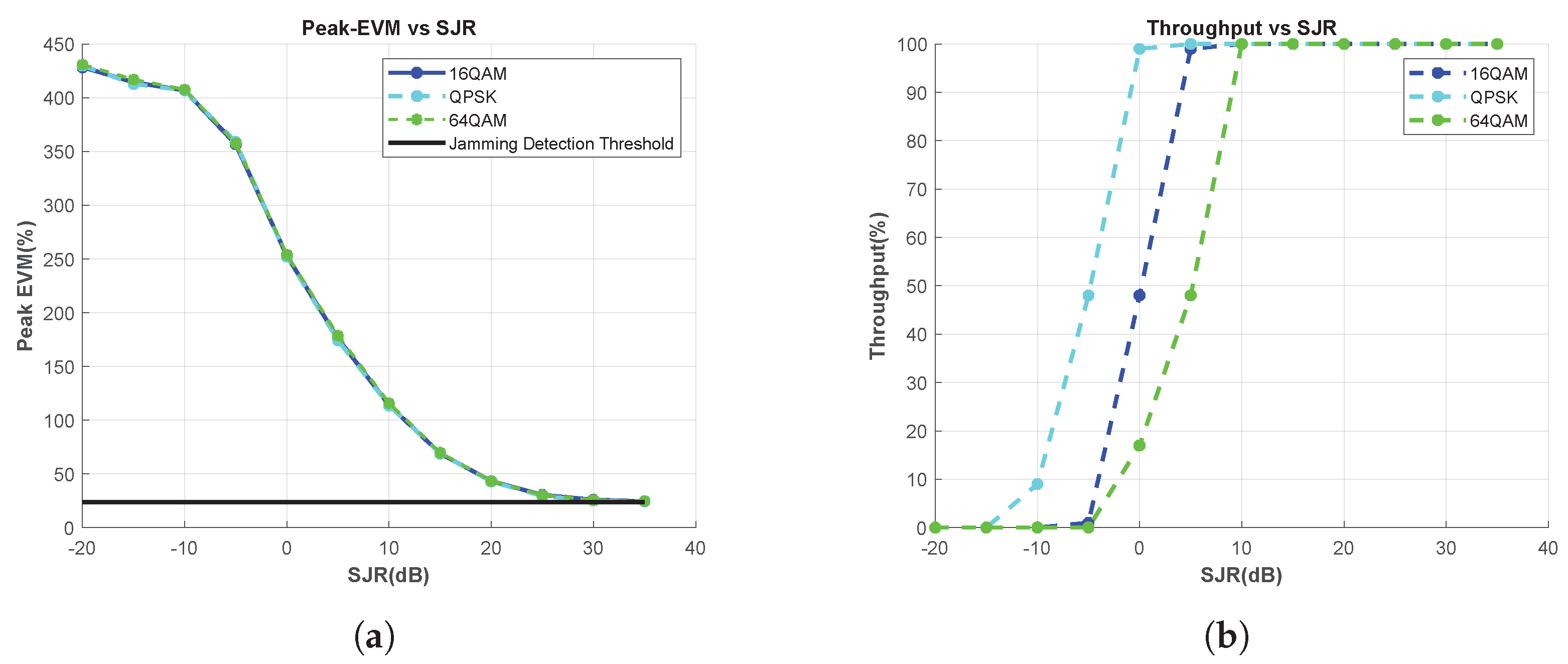

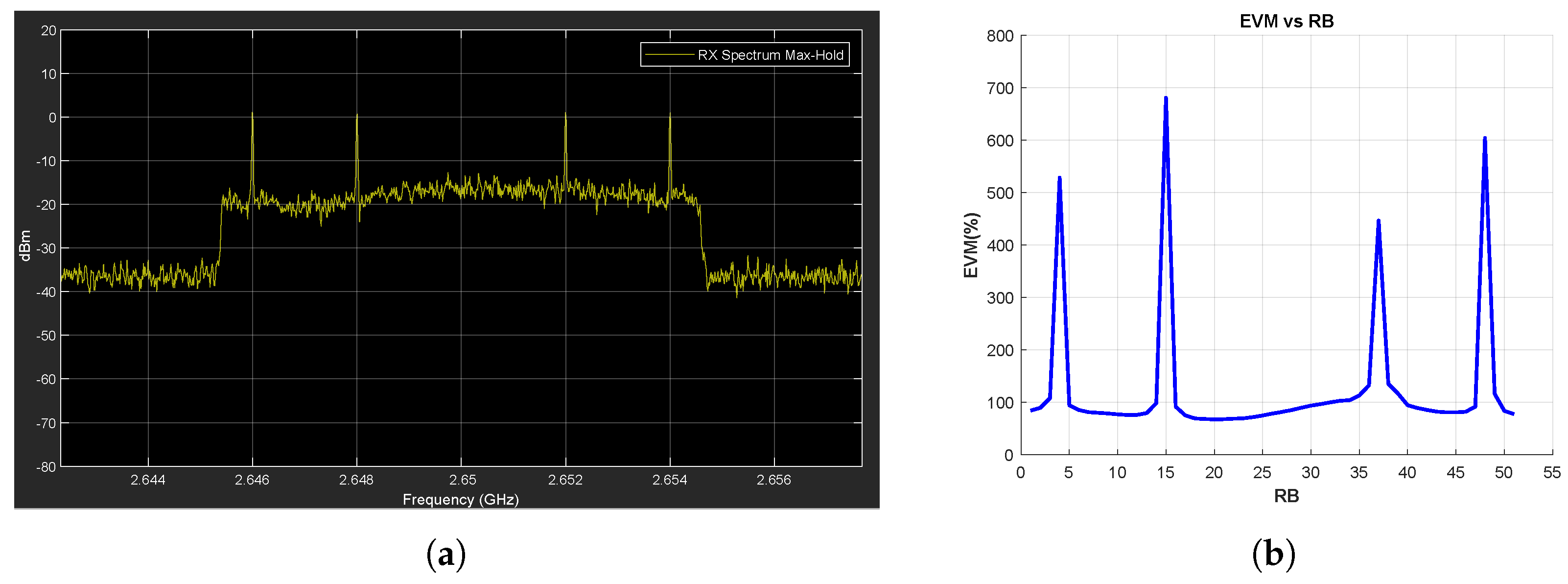
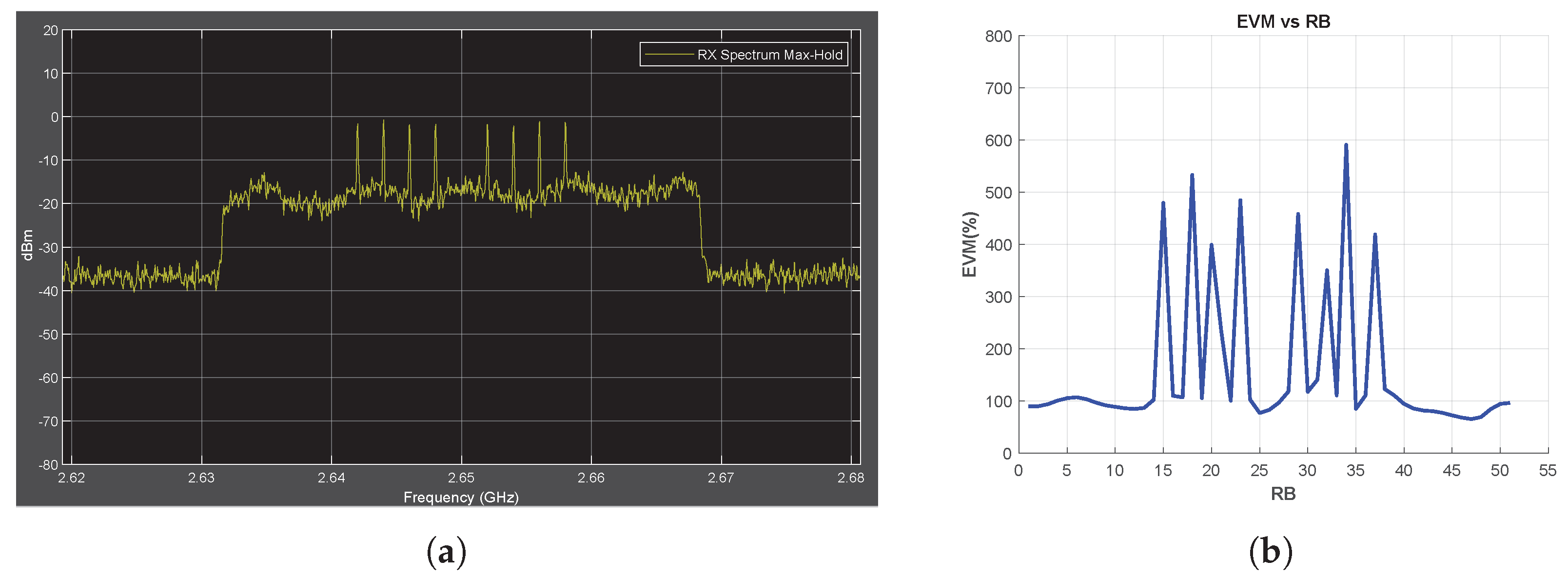
References
- Pirayesh, H.; Zeng, H. Jamming Attacks and Anti-Jamming Strategies in Wireless Networks: A Comprehensive Survey. IEEE Commun. Surv. Tutor. 2022, 24, 767–809. [Google Scholar] [CrossRef]
- Grover, K.; Lim, A.; Yang, Q. Jamming and anti-jamming techniques in wireless networks: A survey. Int. J. Ad Hoc Ubiquitous Comput. 2014, 17, 197. [Google Scholar] [CrossRef]
- Xu, H.; Cheng, Y.; Wang, P. Jamming Detection in Broadband Frequency Hopping Systems Based on Multi-Segment Signals Spectrum Clustering. IEEE Access 2021, 9, 29980–29992. [Google Scholar] [CrossRef]
- Liu, Z.; Liu, H.; Xu, W.; Chen, Y. An Error-Minimizing Framework for Localizing Jammers in Wireless Networks. IEEE Trans. Parallel Distrib. Syst. 2014, 25, 508–517. [Google Scholar] [CrossRef]
- Mughal, M.O.; Dabcevic, K.; Marcenaro, L.; Regazzoni, C.S. Compressed sensing based jammer detection algorithm for wide-band cognitive radio networks. In Proceedings of the 2015 3rd International Workshop on Compressed Sensing Theory and Its Applications to Radar, Sonar and Remote Sensing (CoSeRa), Pisa, Italy, 17–19 June 2015; pp. 119–123. [Google Scholar] [CrossRef]
- Hamdy, A.; Digham, F.; Nasr, O.A.; Mourad, H.M. Automatic detection of jammer interference in GSM networks. In Proceedings of the 2018 International Conference on Innovative Trends in Computer Engineering (ITCE), Aswan, Egypt, 19–21 February 2018; pp. 248–252. [Google Scholar] [CrossRef]
- Ferre, R.M.; Richter, P.; Fuente, A.D.L.; Lohan, E.S. In-lab validation of jammer detection and direction finding algorithms for GNSS. In Proceedings of the 2019 International Conference on Localization and GNSS (ICL-GNSS), Nuremberg, Germany, 4–6 June 2019; pp. 1–6. [Google Scholar] [CrossRef]
- Xu, S.; Xu, W.; Pan, C.; Elkashlan, M. Detection of Jamming Attack in Non-Coherent Massive SIMO Systems. IEEE Trans. Inf. Forensics Secur. 2019, 14, 2387–2399. [Google Scholar] [CrossRef]
- Akhlaghpasand, H.; Razavizadeh, S.M.; Björnson, E.; Do, T.T. Jamming Detection in Massive MIMO Systems. IEEE Wirel. Commun. Lett. 2018, 7, 242–245. [Google Scholar] [CrossRef]
- Eygi, M.; Kurt, G.K. Jamming Detection: A Multicarrier Approach. In Proceedings of the 2018 26th Telecommunications Forum (TELFOR), Belgrade, Serbia, 20–21 November 2018; pp. 1–4. [Google Scholar] [CrossRef]
- Chen, X.; Yang, W. Detection of Jamming in DSSS Systems Using FRESH Filters. In Proceedings of the 2020 IEEE 3rd International Conference of Safe Production and Informatization (IICSPI), Chongqing, China, 28-30 November 2020; pp. 320–325. [Google Scholar] [CrossRef]
- Choi, J.; Mughal, M.O.; Choi, Y.; Kim, D.; Lopez-Salcedo, J.A.; Kim, S. CUSUM-based Joint Jammer Detection and Localization. In Proceedings of the 2018 IEEE International Symposium on Dynamic Spectrum Access Networks (DySPAN), Seoul, Republic of Korea, 22–25 October 2018; pp. 1–5. [Google Scholar] [CrossRef]
- Eriksson, G.; Hansson, A. Derivation of detection times for a simple follower-jammer model used in mobile ad hoc-network simulations. In Proceedings of the 2019 International Conference on Military Communications and Information Systems (ICMCIS), Budva, Montenegro, 14–15 May 2019; pp. 1–5. [Google Scholar] [CrossRef]
- Mohammadi, J.; Stańczak, S.; Zheng, M. Joint spectrum sensing and jamming detection with correlated channels in cognitive radio networks. In Proceedings of the 2015 IEEE International Conference on Communication Workshop (ICCW), London, UK, 8–12 June 2015; pp. 889–894. [Google Scholar] [CrossRef]
- Liu, M.; Jin, L.; Shang, B. LSTM-Based Jamming Detection for Satellite Communication with Alpha-Stable Noise. In Proceedings of the 2021 IEEE Wireless Communications and Networking Conference Workshops (WCNCW), Nanjing, China, 29 March 2021; pp. 1–5. [Google Scholar] [CrossRef]
- Malebary, S.; Xu, W.; Huang, C.-T. Jamming mobility in 802.11p networks: Modeling, evaluation, and detection. In Proceedings of the 2016 IEEE 35th International Performance Computing and Communications Conference (IPCCC), Las Vegas, NV, USA, 9–11 December 2016; pp. 1–7. [Google Scholar] [CrossRef]
- Manju, V.C.; Kumar, M.S. Detection of jamming style DoS attack in Wireless Sensor Network. In Proceedings of the 2012 2nd IEEE International Conference on Parallel, Distributed and Grid Computing, Solan, India, 6–8 December 2012; pp. 563–567. [Google Scholar] [CrossRef]
- Bodkhe, A.A.; Raut, A.R. Identifying Jammers in Wireless Sensor Network with an Approach to Defend Reactive Jammer. In Proceedings of the 2014 Fourth International Conference on Communication Systems and Network Technologies, Bhopal, India, 7–9 April 2014; pp. 89–92. [Google Scholar] [CrossRef]
- Yu, B.; Zhang, L.-Y. An improved detection method for different types of jamming attacks in wireless networks. In Proceedings of the 2014 2nd International Conference on Systems and Informatics (ICSAI 2014), Shanghai, China, 15–17 November 2014; pp. 553–558. [Google Scholar] [CrossRef]
- Marttinen, A.; Wyglinski, A.M.; Jäntti, R. Statistics-Based Jamming Detection Algorithm for Jamming Attacks against Tactical MANETs. In Proceedings of the 2014 IEEE Military Communications Conference, Baltimore, MD, USA, 6–8 October 2014; pp. 501–506. [Google Scholar] [CrossRef]
- Sufyan, N.; Saqib, N.A.; Zia, M. Detection of jamming attacks in 802.11b wireless networks. J. Wirel. Commun. Netw. 2013, 2013, 208. [Google Scholar] [CrossRef]
- Liu, G.; Liu, J.; Li, Y.; Xiao, L.; Tang, Y. Jamming Detection of Smartphones for WiFi Signals. In Proceedings of the 2015 IEEE 81st Vehicular Technology Conference (VTC Spring), Glasgow, UK, 11–14 May 2015; pp. 1–3. [Google Scholar] [CrossRef]
- Duan, B.; Yin, D.; Cong, Y.; Zhou, H.; Xiang, X.; Shen, L. Anti-Jamming Path Planning for Unmanned Aerial Vehicles with Imperfect Jammer Information. In Proceedings of the 2018 IEEE International Conference on Robotics and Biomimetics (ROBIO), Kuala Lumpur, Malaysia, 12–15 December 2018; pp. 729–735. [Google Scholar] [CrossRef]
- Arjoune, Y.; Salahdine, F.; Islam, M.S.; Ghribi, E.; Kaabouch, N. A Novel Jamming Attacks Detection Approach Based on Machine Learning for Wireless Communication. In Proceedings of the 2020 International Conference on Information Networking (ICOIN), Barcelona, Spain, 7–10 January 2020; pp. 459–464. [Google Scholar] [CrossRef]
- Jahanshahi, J.A.; Ghorashi, S.A.; Eslami, M. A support vector machine based algorithm for jamming attacks detection in cellular networks. In Proceedings of the 2011 Wireless Advanced, London, UK, 20–22 June 2011; pp. 180–184. [Google Scholar] [CrossRef]
- Puñal, O.; Aktaş, I.; Schnelke, C.-J.; Abidin, G.; Wehrle, K.; Gross, J. Machine learning-based jamming detection for IEEE 802.11: Design and experimental evaluation. In Proceedings of the IEEE International Symposium on a World of Wireless, Mobile and Multimedia Networks 2014, Sydney, NSW, Australia, 19 June 2014; pp. 1–10. [Google Scholar]
- Upadhyaya, B.; Sun, S.; Sikdar, B. Machine Learning-based Jamming Detection in Wireless IoT Networks. In Proceedings of the 2019 IEEE VTS Asia Pacific Wireless Communications Symposium (APWCS), Singapore, 28–30 August 2019; pp. 1–5. [Google Scholar] [CrossRef]
- Spuhler, M.; Giustiniano, D.; Lenders, V.; Wilhelm, M.; Schmitt, J.B. Detection of Reactive Jamming in DSSS-based Wireless Communications. IEEE Trans. Wirel. Commun. 2014, 13, 1593–1603. [Google Scholar] [CrossRef]
- Osanaiye, O.; Alfa, A.S.; Hancke, G.P. A Statistical Approach to Detect Jamming Attacks in Wireless Sensor Networks. Sensors 2018, 18, 1691. [Google Scholar] [CrossRef] [PubMed]
- Morales Ferre, R.; de la Fuente, A.; Lohan, E.S. Jammer Classification in GNSS Bands Via Machine Learning Algorithms. Sensors 2019, 19, 4841. [Google Scholar] [CrossRef] [PubMed]
- Shi, Y.; Davaslioglu, K.; Sagduyu, Y.E.; Headley, W.C.; Fowler, M.; Green, G. Deep Learning for RF Signal Classification in Unknown and Dynamic Spectrum Environments. In Proceedings of the 2019 IEEE International Symposium on Dynamic Spectrum Access Networks (DySPAN), Newark, NJ, USA, 11–14 November 2019; pp. 1–10. [Google Scholar] [CrossRef]
- Li, T.; Wang, M.; Peng, D.; Yang, X. Identification of Jamming Factors in Electronic Information System Based on Deep Learning. In Proceedings of the 2018 IEEE 18th International Conference on Communication Technology (ICCT), Chongqing, China, 8–11 October 2018; pp. 1426–1430. [Google Scholar] [CrossRef]
- Zhang, N.; Li, Y.; Shi, Y.; Shen, J. A CNN-Based Adaptive Federated Learning Approach for Communication Jamming Recognition. Electronics 2023, 12, 3425. [Google Scholar] [CrossRef]
- Shen, J.; Li, Y.; Zhu, Y.; Wan, L. Cooperative Multi-Node Jamming Recognition Method Based on Deep Residual Network. Electronics 2022, 11, 3280. [Google Scholar] [CrossRef]
- Vinogradova, J.; Björnson, E.; Larsson, E.G. Detection and mitigation of jamming attacks in massive MIMO systems using random matrix theory. In Proceedings of the 2016 IEEE 17th International Workshop on Signal Processing Advances in Wireless Communications (SPAWC), Edinburgh, UK, 3–6 July 2016; pp. 1–5. [Google Scholar] [CrossRef]
- Yang, X.; Li, A.; Wei, M.; Zhang, X.; Lu, S.; Wang, W. Jamming Signal Detection Based on TSVD Method. In Proceedings of the 2020 IEEE International Conference on Advances in Electrical Engineering and Computer Applications( AEECA), Dalian, China, 25–27 August 2020; pp. 558–562. [Google Scholar] [CrossRef]
- Örnek, C.; Kartal, M. An Efficient EVM Based Jamming Detection in 5G Networks. In Proceedings of the 2022 4th IEEE Middle East and North Africa COMMunications Conference (MENACOMM), Amman, Jordan, 6–8 December 2022; pp. 130–135. [Google Scholar] [CrossRef]
- Alakoca, H.; Kurt, G.K.; Ayyıldız, C. PHY based Jamming attacks against OFDM systems: A measurement study. In Proceedings of the 2017 25th Telecommunication Forum (TELFOR), Belgrade, Serbia, 21–22 November 2017; pp. 1–4. [Google Scholar] [CrossRef]
- Bilodeau-Robitaille, O.; Gagnon, F. Digital RF Memory Jamming on OFDM SISO. In Proceedings of the 2014 IEEE Military Communications Conference, Baltimore, MD, USA, 6–8 October 2014; pp. 1542–1548. [Google Scholar] [CrossRef]
- Örnek, C.; Kartal, M. Work-in-Progress: An Efficient EVM Based Hybrid Jammer Localization Method for 5G Networks. In Proceedings of the 2023 IEEE International Black Sea Conference on Communications and Networking (BlackSeaCom), Istanbul, Turkiye, 4–7 July 2023; pp. 408–413. [Google Scholar] [CrossRef]
- Zheng, K.; Jia, X.; Chi, K.; Liu, X. DDPG-Based Joint Time and Energy Management in Ambient Backscatter-Assisted Hybrid Underlay CRNs. IEEE Trans. Commun. 2023, 71, 441–456. [Google Scholar] [CrossRef]
- Zheng, K.; Luo, R.; Wang, Z.; Liu, X.; Yao, Y. Short-Term and Long-Term Throughput Maximization in Mobile Wireless-Powered Internet of Things. IEEE Internet Things J. 2023. [Google Scholar] [CrossRef]
- MATLAB R2021a; The MathWorks, Inc.: Natick, MA, USA, 2021.
- 3GPP TS 38.212. NR; Multiplexing and Channel Coding. 3rd Generation Partnership Project; Technical Specification Group Radio Access Network: Sophia Antipolis Cedex, France, 2020.
- 3GPP TS 38.202. NR; Services Provided by the Physical Layer. 3rd Generation Partnership Project; Technical Specification Group Radio Access Network: Sophia Antipolis Cedex, France, 2020.
- 3GPP TS 38.214. NR; Physical Layer Procedures for Data. 3rd Generation Partnership Project; Technical Specification Group Radio Access Network: Sophia Antipolis Cedex, France, 2020.
- 3GPP TS 38.211. NR; Physical Channels and Modulation. 3rd Generation Partnership Project; Technical Specification Group Radio Access Network: Sophia Antipolis Cedex, France, 2020.
- 3GPP TR 38.901. 5G; Study on Channel Model for Frequencies from 0.5 to 100 GHz. Technical Specification Group Radio Access Network: Sophia Antipolis Cedex, France, 2020.
- Paulraj, A.; Nabar, R.; Gore, D. ; Introduction to Space-Time Wireless Communications; Cambridge University Press: Cambridge, UK, 2003; pp. 84–186. [Google Scholar]
- Arjoune, Y.; Faruque, S. Smart Jamming Attacks in 5G New Radio: A Review. In Proceedings of the 2020 10th Annual Computing and Communication Workshop and Conference (CCWC), Las Vegas, NV, USA, 6–8 January 2020; pp. 1010–1015. [Google Scholar] [CrossRef]



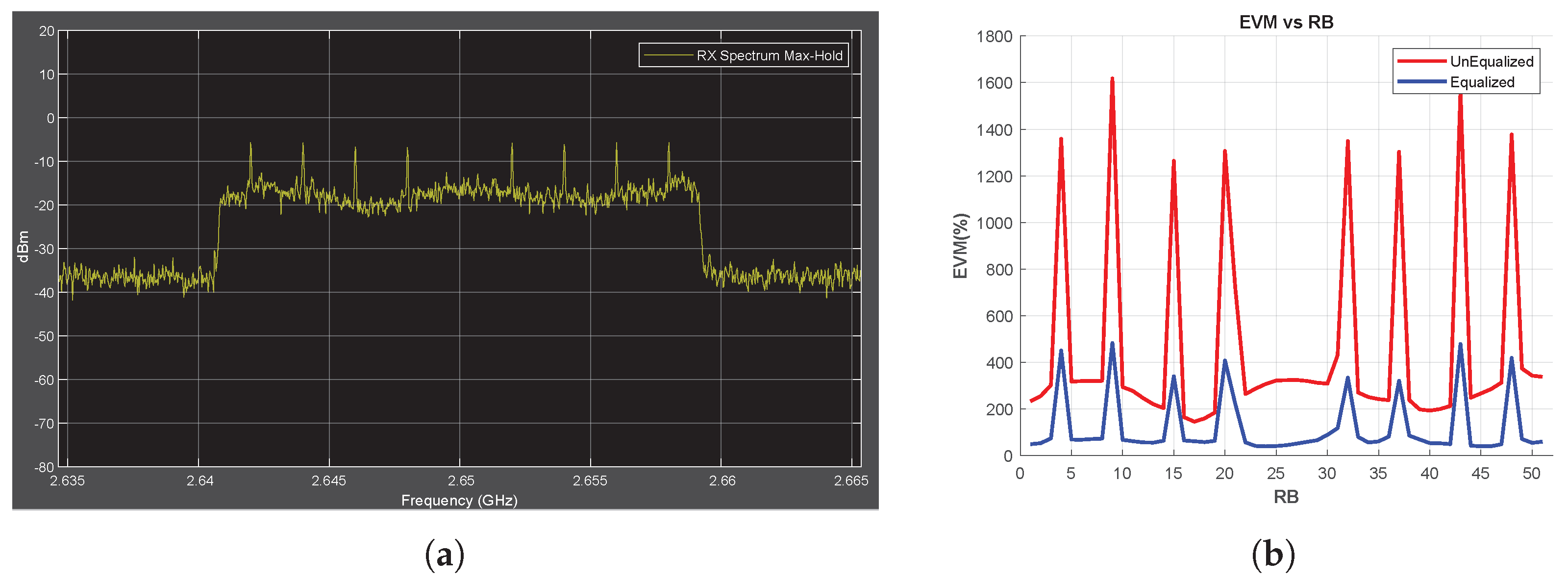
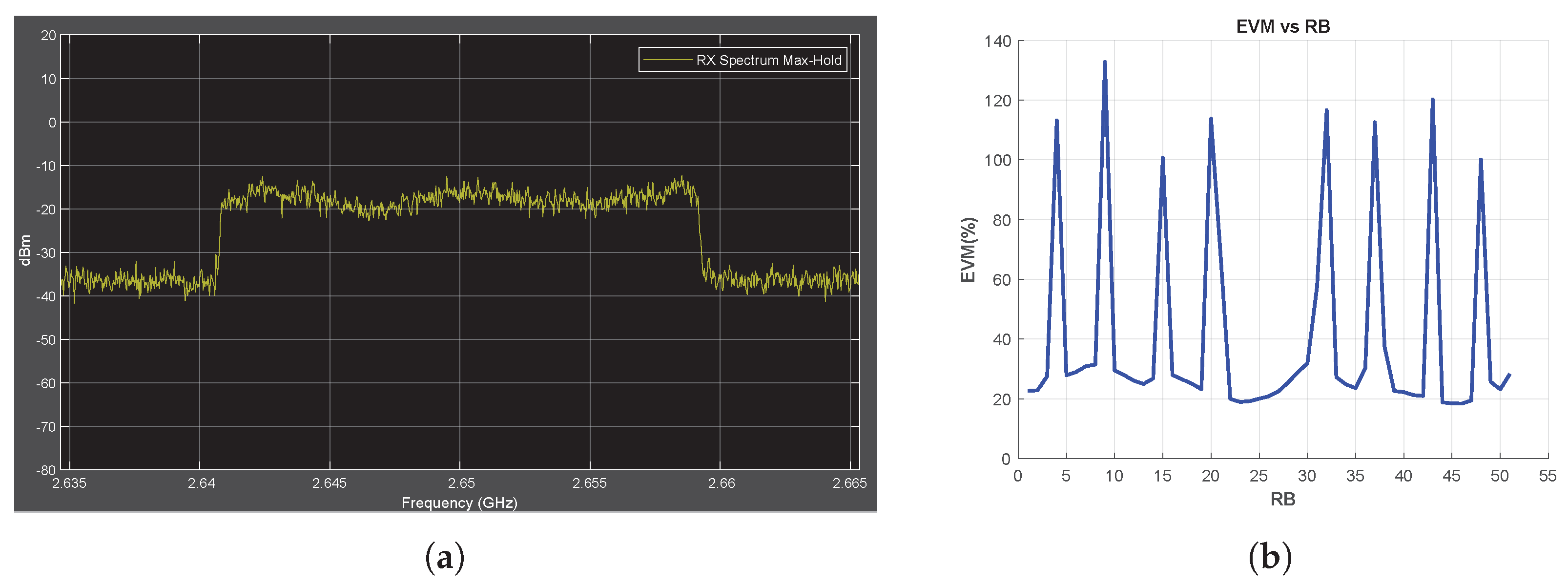
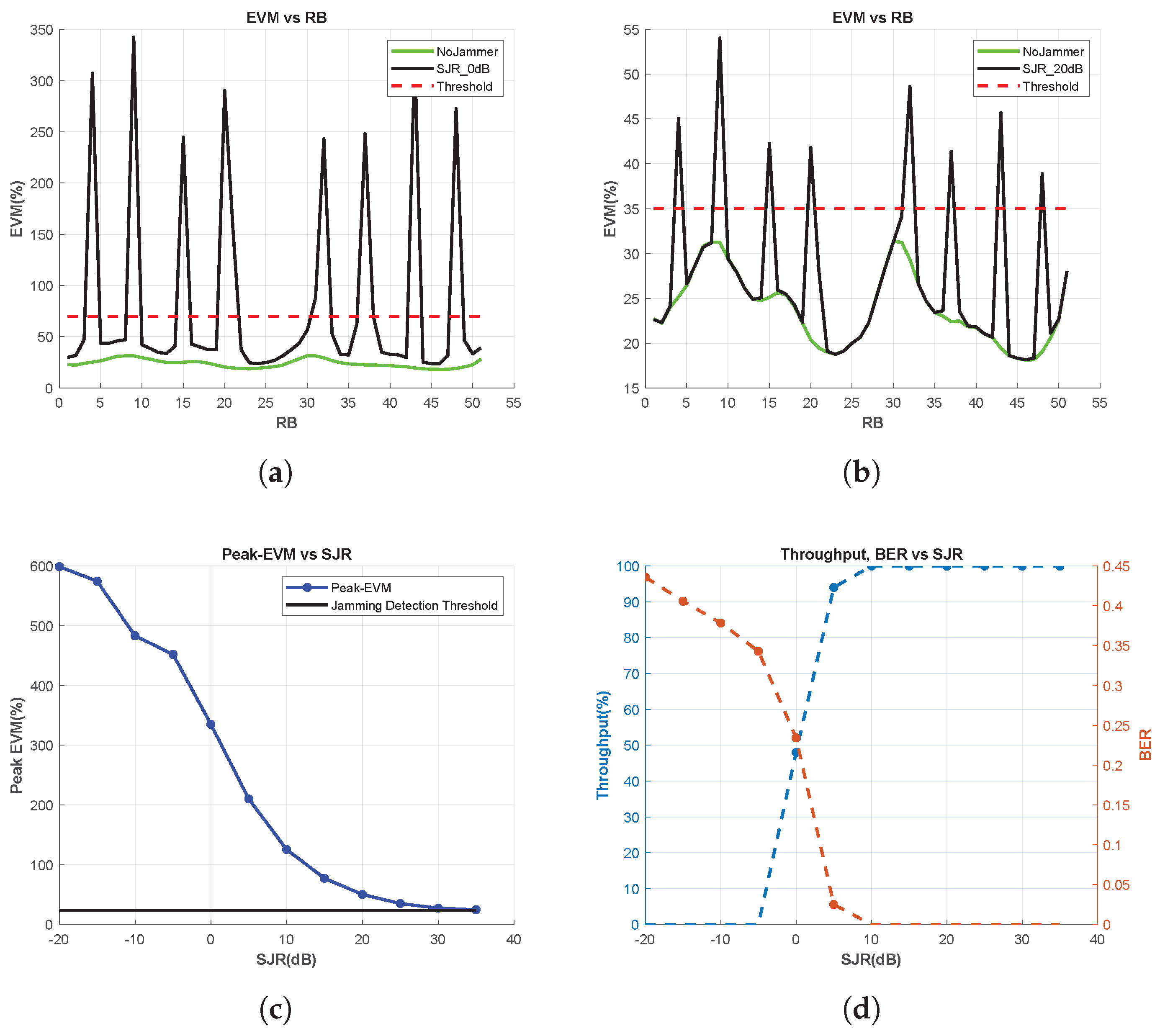


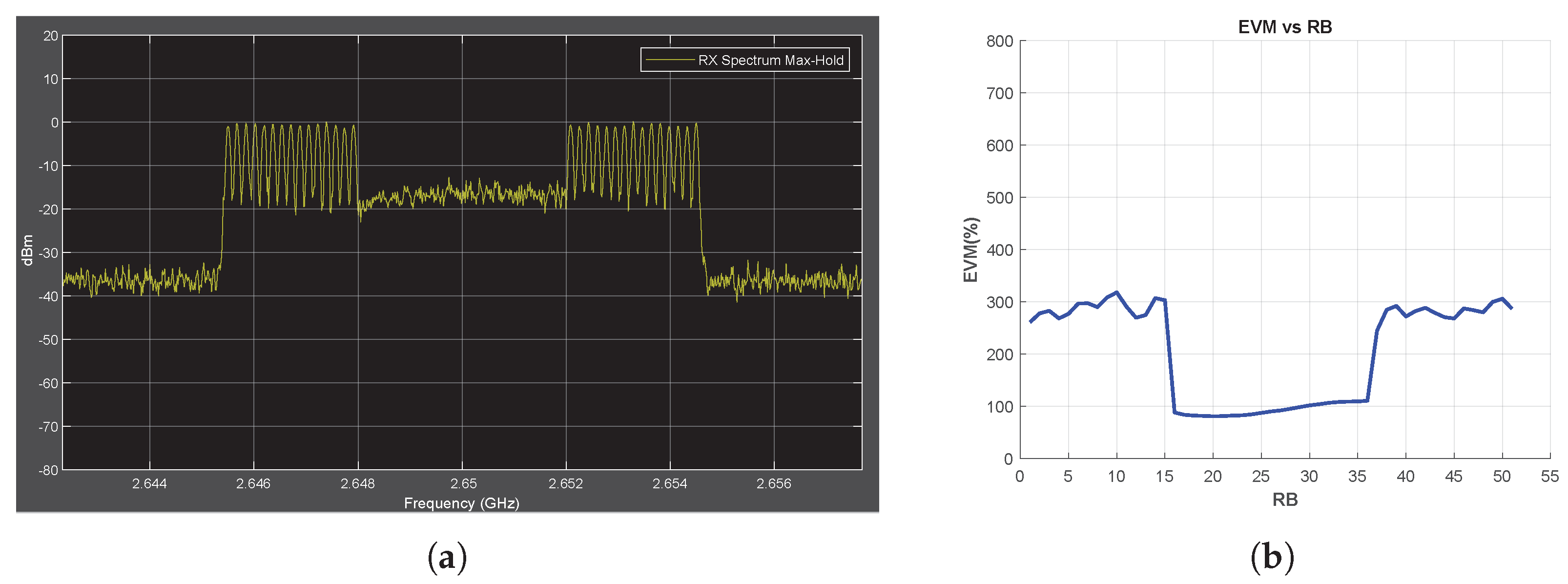

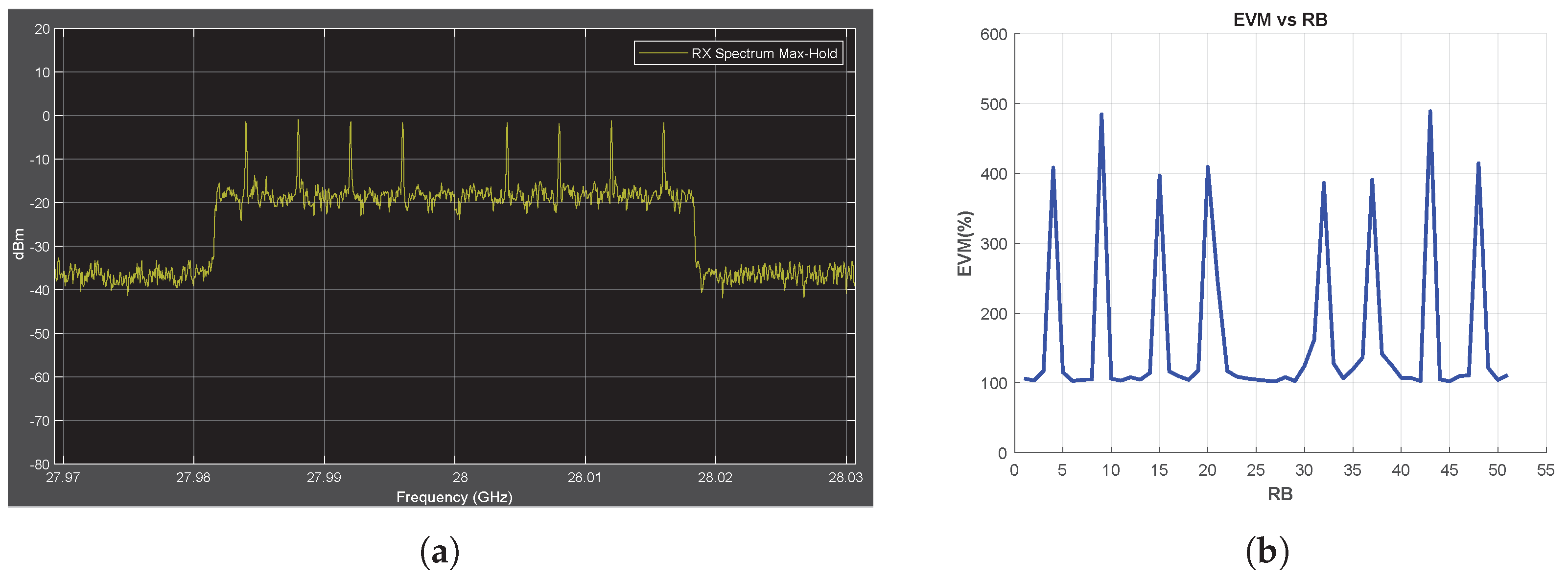
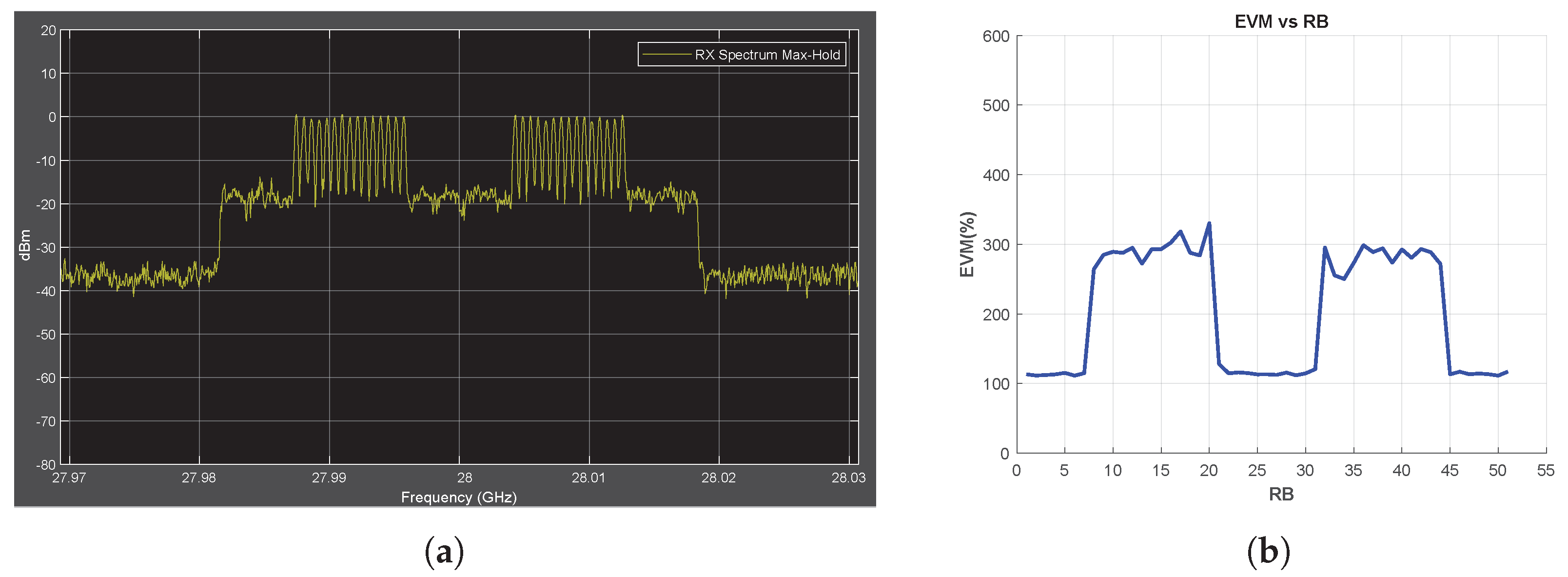
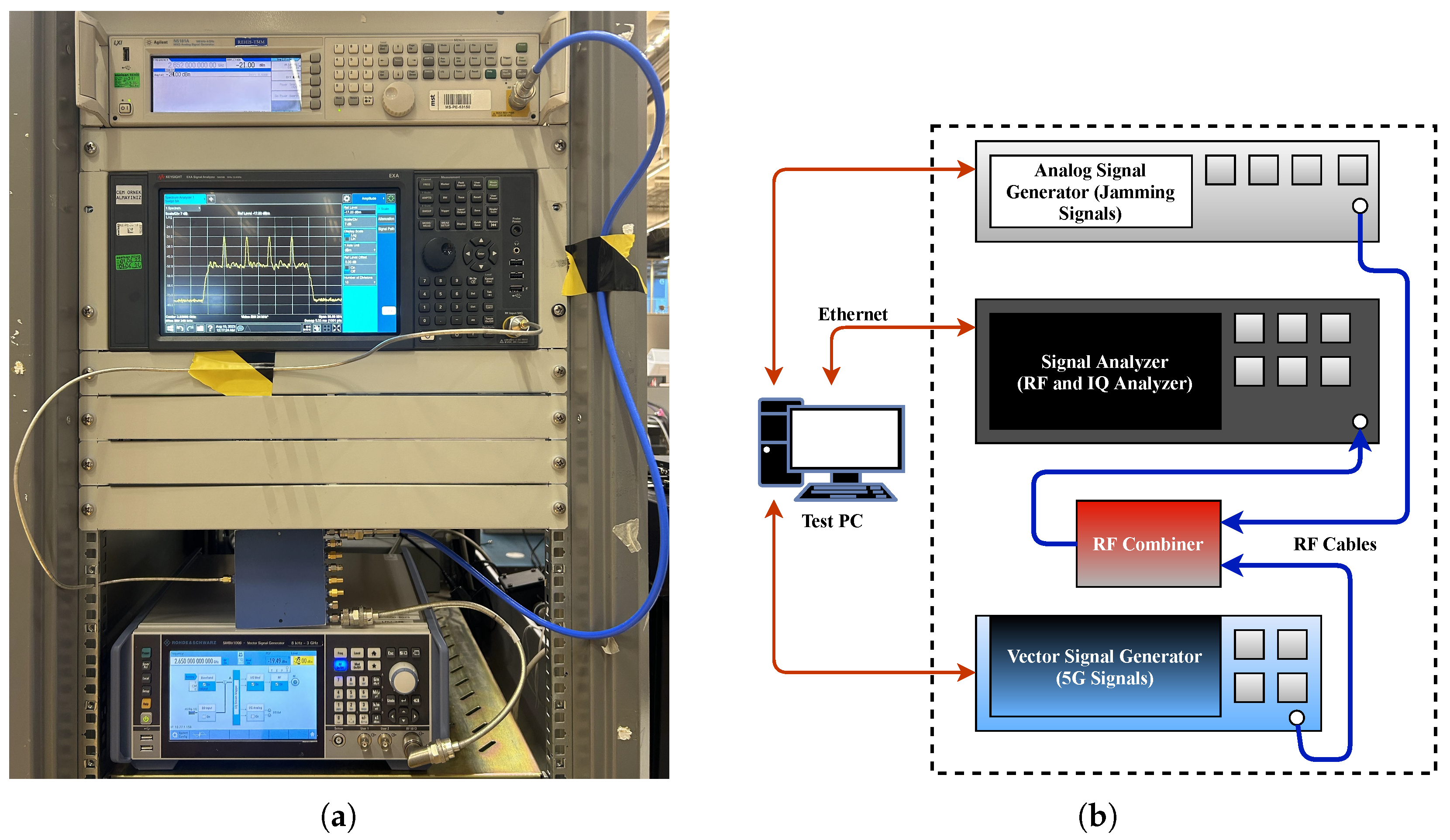
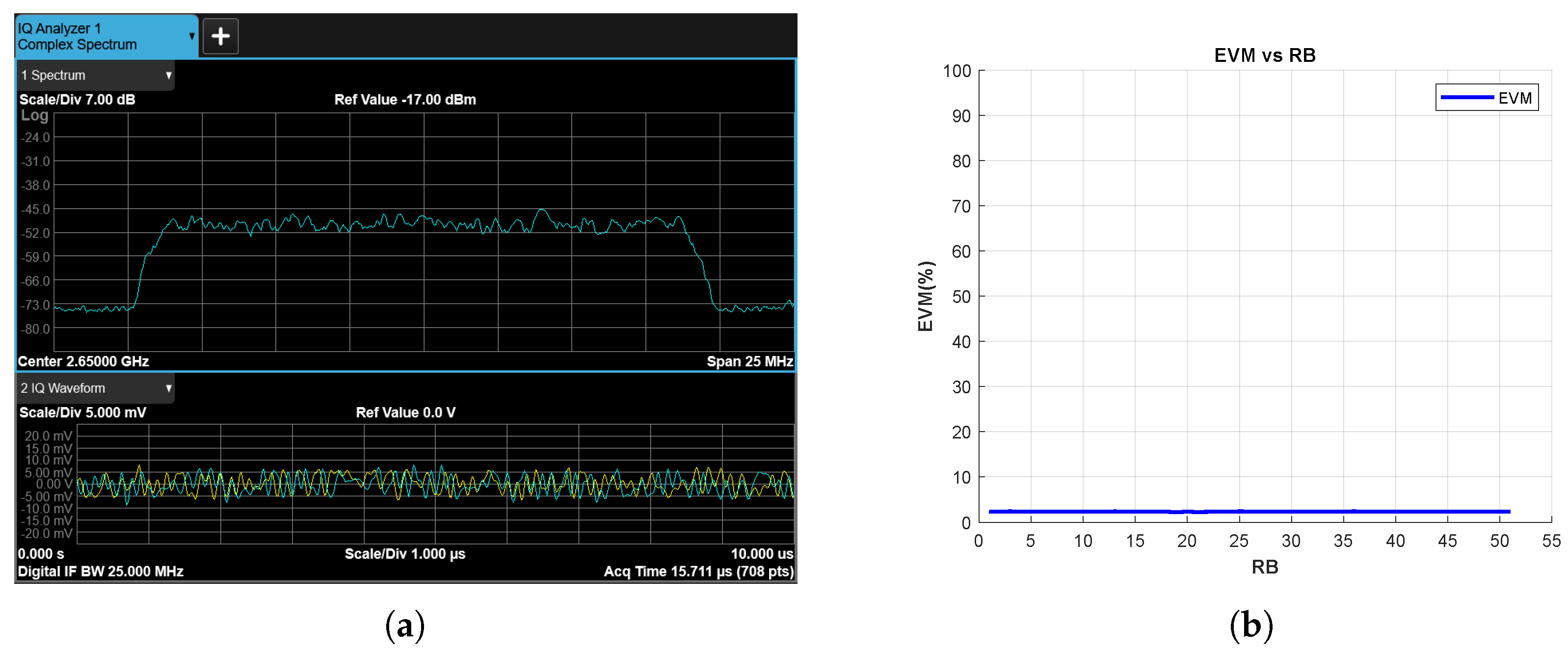
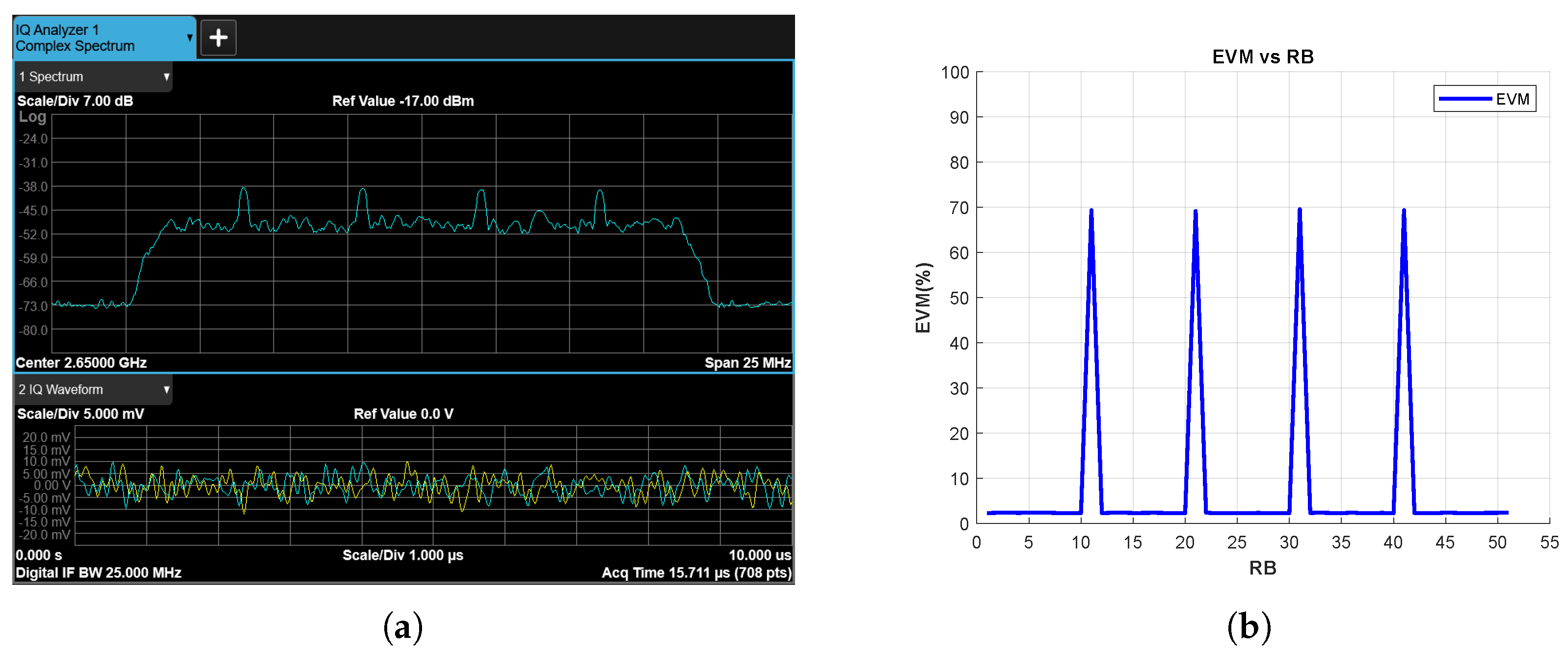


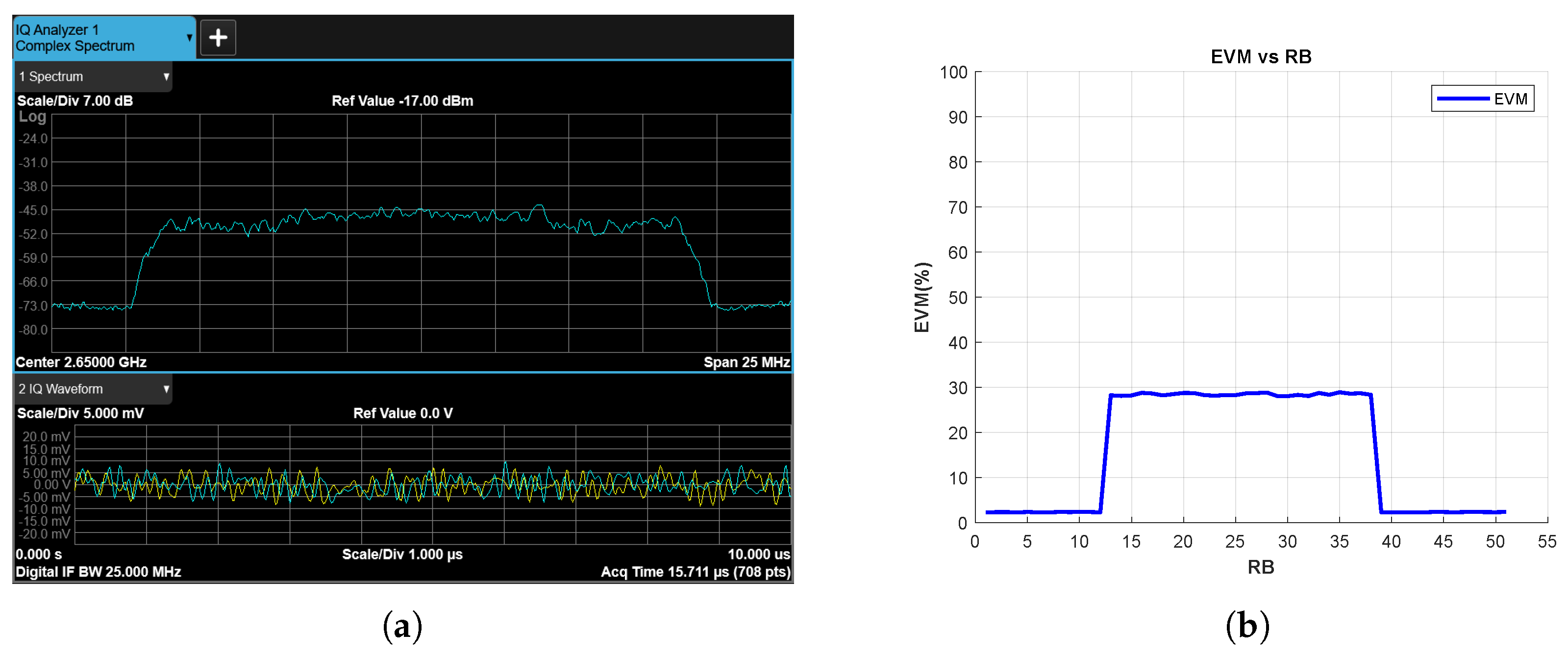
| Parameter Name | Value | Explanation |
|---|---|---|
| Carrier Frequency | 2.65 GHz | Frequency Range-1 for 5G |
| MIMO Structure | 8 × 2 | |
| MIMO Transmission Layers | 2 | |
| Fading Channel Model | CDL-C | Urban Macrocell Model, NLOS |
| OFDM Subcarrier Spacing (SCS) | 30 kHz | (numerology) |
| Assigned RBs | 51 | Transmission bandwidth close to 20 MHz with the 30 kHz SCS |
| IQ Modulation | 16QAM | |
| Code Rate | 490/1024 |
Disclaimer/Publisher’s Note: The statements, opinions and data contained in all publications are solely those of the individual author(s) and contributor(s) and not of MDPI and/or the editor(s). MDPI and/or the editor(s) disclaim responsibility for any injury to people or property resulting from any ideas, methods, instructions or products referred to in the content. |
© 2023 by the authors. Licensee MDPI, Basel, Switzerland. This article is an open access article distributed under the terms and conditions of the Creative Commons Attribution (CC BY) license (https://creativecommons.org/licenses/by/4.0/).
Share and Cite
Örnek, C.; Kartal, M. Securing the Future: A Resourceful Jamming Detection Method Utilizing the EVM Metric for Next-Generation Communication Systems. Electronics 2023, 12, 4948. https://doi.org/10.3390/electronics12244948
Örnek C, Kartal M. Securing the Future: A Resourceful Jamming Detection Method Utilizing the EVM Metric for Next-Generation Communication Systems. Electronics. 2023; 12(24):4948. https://doi.org/10.3390/electronics12244948
Chicago/Turabian StyleÖrnek, Cem, and Mesut Kartal. 2023. "Securing the Future: A Resourceful Jamming Detection Method Utilizing the EVM Metric for Next-Generation Communication Systems" Electronics 12, no. 24: 4948. https://doi.org/10.3390/electronics12244948
APA StyleÖrnek, C., & Kartal, M. (2023). Securing the Future: A Resourceful Jamming Detection Method Utilizing the EVM Metric for Next-Generation Communication Systems. Electronics, 12(24), 4948. https://doi.org/10.3390/electronics12244948






